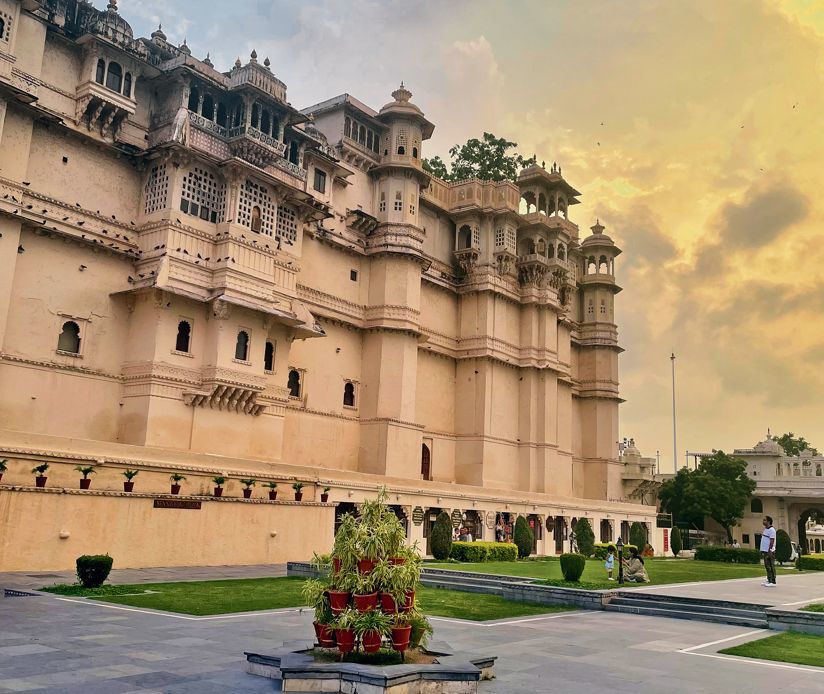Magic in the monsoon: Udaipur’s majestic palaces, ancient temples and jewel-like lakes seem to come alive when it rains
Teja Lele
BIG, fat raindrops kiss the parched surface of the earth, the smell of petrichor creating an enchanting ambience. From the lakefront restaurant I’m sitting at, I watch the rain make its way into Lake Pichola, the drops creating ripples as they disappear into the water. The artificial freshwater lake and its surroundings have been developed over the centuries, and the palaces, marble temples, chabutaras, and the bathing ghats — Ambrai, Gangaur and Hanuman — create a gorgeous picture. Udaipur in Rajasthan is a beautiful destination at any time of the year, but the monsoon makes it magical.
Founded in 1559 by Udai Singh II of the Sisodia clan of Rajputs, Udaipur was the capital of Mewar and remained so till 1818 when it became a British princely state. Udai Singh II set up the city in the fertile circular Girwa valley, and built a 6-km-long city wall, with seven gates, to keep it safe. The area within these seven gates — Udaipole, Surajpole, Chandpole, Hathipole, Kishanpole, Ambapole, Brahmpole — and Delhi Gate is now known as the old city and houses most of the old structures. It’s easy to see why Udaipur has been dubbed the most romantic city in India, beginning with British administrator James Tod and going on to countless publications and surveys. Lakes and hills, palaces and temples, museums and cafes, busy markets and winding streets, there’s plenty to do in this big city with a small-town vibe.
My explorations begin at the magnificent City Palace, located on Lake Pichola and built at different times starting in 1559. Tripolia, a triple-arched gate built in 1725, leads to a series of courtyards, terraces, corridors, rooms and gardens. It’s home to a museum that spotlights the architecture, paintings, furniture and other artefacts from a bygone era.
On our way back home that night, we stop at Jagdish temple, which stands stolidly in the midst of the old city. Built by Maharana Jagat Singh I and in continuous worship since 1651, the temple showcases the Maru-Gurjara style of architecture, with numerous ornate carvings.
I lay eyes upon the Fatehsagar Lake, glimmering in the moonlight, as we drive back. Bounded by the Aravalli hills on three sides, the lake is a favourite with locals and tourists alike, offering boating and other activities by day, and peace and calm by night.
The numerous water bodies around the city add to the splendour of this aptly-named City of Lakes. The five most beautiful and most prominent are Pichola, Udai Sagar, Fateh Sagar, Rajsamand and Jaisamand, all included in the government’s National Lake Conservation Plan. Apart from these, other smaller lakes such as Badi Talab, Doodh Talai and Kumharia Talab are also part of the city’s watercourses.
The next day, a boat ride takes us to Jag Mandir, a palace built on a small island in Lake Pichola. As the elegant façade, flanked by four massive carved statues of elephants on either side, comes into view, it becomes apparent why the royals used the structure as a summer and pleasure palace. Also known as the Lake Garden Palace, the elegant three-storeyed structure includes a garden area, complete with a black-and-white tiled courtyard, fountains and water pools.
I spot the beautiful Lake Palace, also located on an island in Lake Pichola, and earlier used as a summer palace. Built of white marble and featuring ornamented niches, pillared terraces, gardens and fountains, it is now a five-star hotel.
Not very far is Saheliyon ki Bari, which becomes even more beautiful in the rainy season. Built by Maharana Sangram Singh as a gift for his queen, the garden complex was designed as a space where the queen could spend time with the 48 maids who accompanied her after marriage. Even today, it’s ideal for long strolls and longer conversations. Other attractions include Moti Magri, a memorial to Rajput hero Maharana Pratap, and Kesariyaji Temple, which has 52 pinnacles and is dedicated to Rishabh Dev, the first Jain Tirthankara.
Most nights, I go to bed replete after tucking into the region’s delicacies: dal baati and churma, gatte ki sabzi, ker sangri, lal maas, and kachori.
On the last day in Udaipur, I make my way to Sajjangarh Palace. Built high up on a hill by Maharana Sajjan Singh in 1884, the marble palace is visually stunning, with a vast central court, high turrets and domes, fountains, jharokhas, and pillars clad with floral motifs. Located 3,100 feet above mean sea level, the palace offers a spectacular view of Fateh Sagar Lake, City Palace and Chittorgarh. Sajjan Singh wanted to build a five-storeyed astronomical centre, but the plan was shelved after his premature death.
The palace was used as a hunting lodge and as a summer lodge. The elevation helped track the movement of monsoon clouds, which led the structure to be called Monsoon Palace. Standing on the terrace, looking out to the sky, I see why — the tumultuous dark clouds reveal that rain is on the way!









